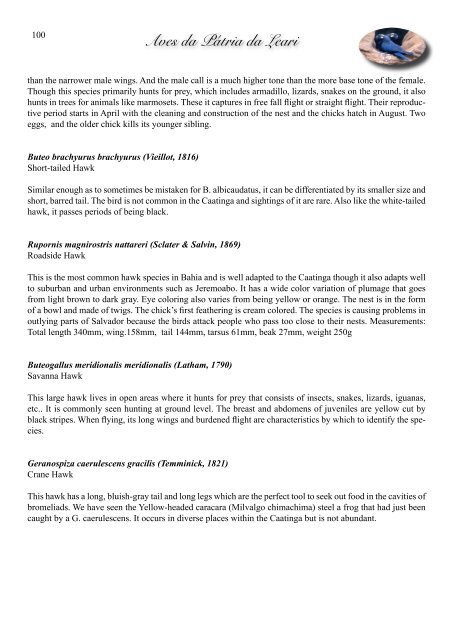Aves da Pátria da Leari - Sociedade Brasileira de Ornitologia
Aves da Pátria da Leari - Sociedade Brasileira de Ornitologia
Aves da Pátria da Leari - Sociedade Brasileira de Ornitologia
You also want an ePaper? Increase the reach of your titles
YUMPU automatically turns print PDFs into web optimized ePapers that Google loves.
100<br />
<strong>Aves</strong> <strong>da</strong> <strong>Pátria</strong> <strong>da</strong> <strong>Leari</strong><br />
than the narrower male wings. And the male call is a much higher tone than the more base tone of the female.<br />
Though this species primarily hunts for prey, which inclu<strong>de</strong>s armadillo, lizards, snakes on the ground, it also<br />
hunts in trees for animals like marmosets. These it captures in free fall flight or straight flight. Their reproductive<br />
period starts in April with the cleaning and construction of the nest and the chicks hatch in August. Two<br />
eggs, and the ol<strong>de</strong>r chick kills its younger sibling.<br />
Buteo brachyurus brachyurus (Vieillot, 1816)<br />
Short-tailed Hawk<br />
Similar enough as to sometimes be mistaken for B. albicau<strong>da</strong>tus, it can be differentiated by its smaller size and<br />
short, barred tail. The bird is not common in the Caatinga and sightings of it are rare. Also like the white-tailed<br />
hawk, it passes periods of being black.<br />
Rupornis magnirostris nattareri (Sclater & Salvin, 1869)<br />
Roadsi<strong>de</strong> Hawk<br />
This is the most common hawk species in Bahia and is well a<strong>da</strong>pted to the Caatinga though it also a<strong>da</strong>pts well<br />
to suburban and urban environments such as Jeremoabo. It has a wi<strong>de</strong> color variation of plumage that goes<br />
from light brown to <strong>da</strong>rk gray. Eye coloring also varies from being yellow or orange. The nest is in the form<br />
of a bowl and ma<strong>de</strong> of twigs. The chick’s first feathering is cream colored. The species is causing problems in<br />
outlying parts of Salvador because the birds attack people who pass too close to their nests. Measurements:<br />
Total length 340mm, wing.158mm, tail 144mm, tarsus 61mm, beak 27mm, weight 250g<br />
Buteogallus meridionalis meridionalis (Latham, 1790)<br />
Savanna Hawk<br />
This large hawk lives in open areas where it hunts for prey that consists of insects, snakes, lizards, iguanas,<br />
etc.. It is commonly seen hunting at ground level. The breast and abdomens of juveniles are yellow cut by<br />
black stripes. When flying, its long wings and bur<strong>de</strong>ned flight are characteristics by which to i<strong>de</strong>ntify the species.<br />
Geranospiza caerulescens gracilis (Temminick, 1821)<br />
Crane Hawk<br />
This hawk has a long, bluish-gray tail and long legs which are the perfect tool to seek out food in the cavities of<br />
bromeliads. We have seen the Yellow-hea<strong>de</strong>d caracara (Milvalgo chimachima) steel a frog that had just been<br />
caught by a G. caerulescens. It occurs in diverse places within the Caatinga but is not abun<strong>da</strong>nt.

















